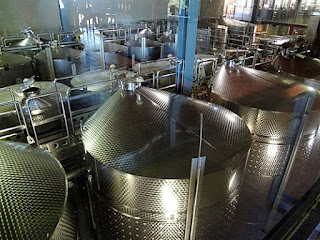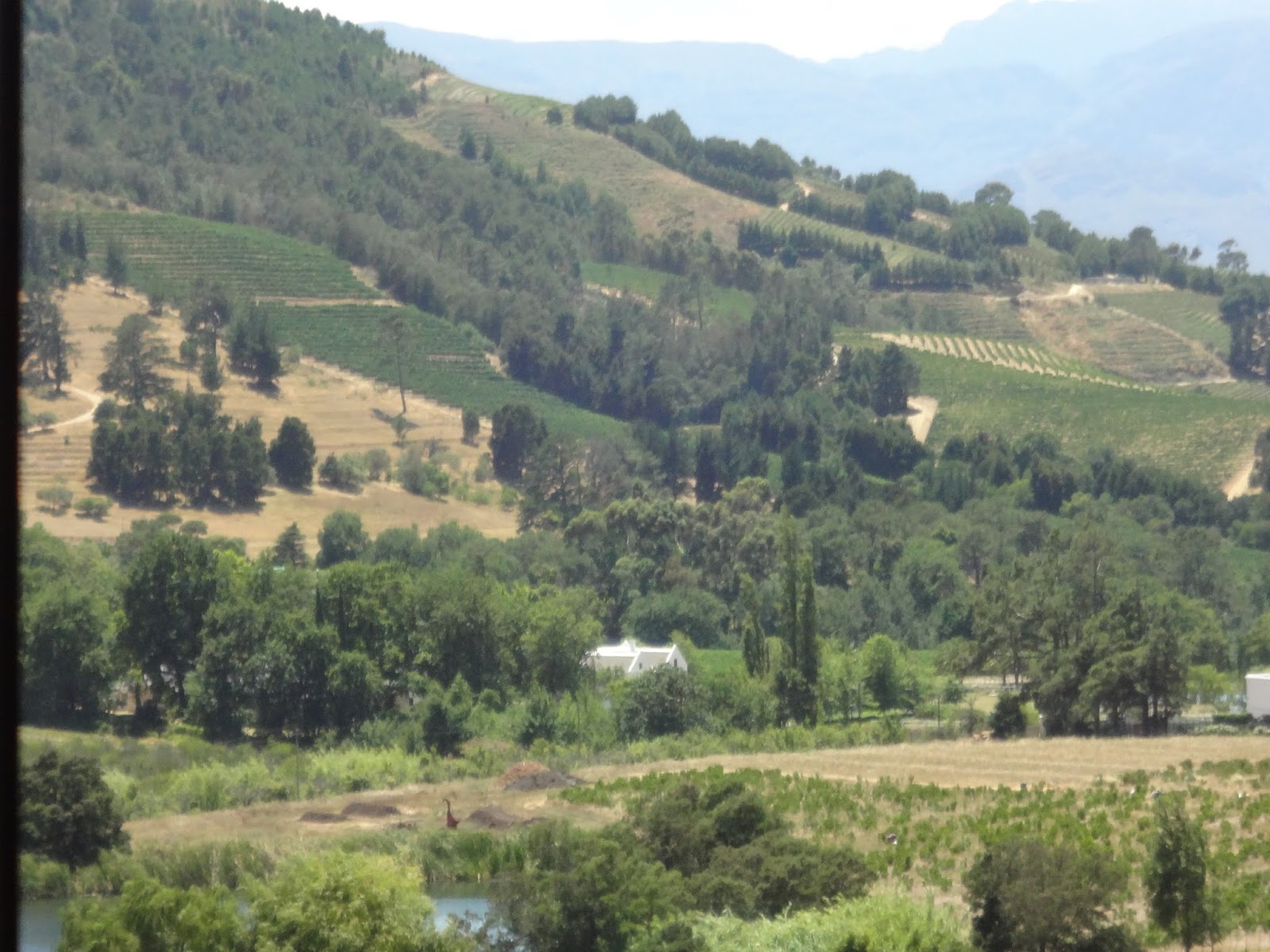I finally found a Zulu basket I liked that would fit my needs. I ended up going back to the first shop by the penguins where I'd seen some I liked and they had a couple of new ones. This is now my shell basket in the boat.
The diamond design represents the "shields of Shaka", a famous Zulu warrior. The basket is grass wrapped in the colored reeds and rolled into the coils. The coils are then woven and stitched together to form the basket.

The mountain of Glen Cairn, next to Simon's Town. A fire on the train blew up the side of this hill in the high winds and scorched the side and came close to some homes. We had a fire nearly every day while we were in Simon's Town. The arsonists must've been very busy.
The bay along the shore where the road and train go into Fish Hoek, the next town where folks go to shop or catch the bus/train. You can see the kelp in the surf.
There is a nice beach here, but in high winds, the sand blows across the railroad track and across the road and forms mini dunes along the road. Much like snow blowing in a blizzard.

This old building is from 1903 in Simon's Town, just across from the train station. The train was only running for two days before it caught fire and was out of commission again for a while. A train ticket included a bus ride from Simon's Town to Fish Hoek to get the train while it was not running way to ST.
A view of False Bay Yacht Club from the top of YOLO's Mast. Jason is up taking pictures of the sheaves in the hopes we can get a rigger to replace one. Getting anyone to work on the boat was like pulling teeth. They have a very different business sense here....
A selfie of Jason at the top of the mast. You can see how the smoke and soot has plastered itself to the front of the mast in the strong winds.
A calm day in the marina for a change. The boat in the center is Saol Eile, our Irish friends. The boat on the left has been shuffling from marina to marina without paying its bills, we heard. They left this dock and headed for another port farther up the coast and the local yacht club here called the Marine Police and Sea Rescue folks and Customs to have it detained for non-paymentof its bills. Whether they finally came up with the funds to pay or it was going to be sold at auction to clear the debts, we aren't sure. We heard both stories.
Kids and teens playing in the waters near the shore in the marina. The platform is there for them to and jump off of. The area here gets lots of use from kids. The kelp covred rock in the foreground is another favorite climbing surface. I like the blow-up swan toy. The dad pulled it behind him with a couple of kids in it. The rounded white walls are the BBQ/braai areas and the picnic areas where folks eat and drink when they come to the yacht club. The Sea Rescue vessels are housed in the big garage-like structure next door. You can see the orange end of one of the rescue boats. They will come to your aid without cost here in South Africa--nice.

Men stoking the fires below their cast iron kettles at the Potjie Kos the yacht club members held for us cruisers. The guy in the blue striped shirt is Mike, and we met him in the Caribbean years ago. He lives here and keeps a boat in the marina, so we got to see him and Lynn a couple of times while we were here.
Jim and Jason waiting for the food to be ready.
These 3-legged cast iron pots were the feature of the day. They set them on top of a fire and bubble up a stew-like mixture that may contain seafood, beef, chicken, lamb or veges. Even bread is cooked over the fire in these things. Every household seems to own one The bowl on the right has cooked white corn maize meal in it, called pap, a staple here in South Africa.

The potjie kos (say poy-key. Don't ask me how that spelling is that pronunciation!) food was delicious and we tried so many different dishes that we didn't need to cook the steaks we'd brought to throw on the barbeque grill.
Linda and Jim from Chesapeake at the potjie kos.
Bill and Tracy at the potjie kos, from Zephyr.
Ann and Chris from Silver Girl at the potjie kos. They were the ones dismasted on the way from Chagos to Rodrigues, but they caught up with us again here in SA.
Ley and Neil from Crystal Blues at the potjie kos.
Jason taking a break inside the clubhouse at FBYC, chatting with other cruisers.
Paul from Thankful and Paraic from Saol Eile enjoy a quieter moment in the bar upstairs at the yacht club.
More cruisers enjoying the party before heading off to their boats at other marinas.
This seal was just snoozing while swimming along between the boats at the dock in the marina.
He'd bump into a boat and just roll or flip over and carry on snoozing. His back flippers as he does a somersault to head in another direction.
You can see the bubbles as he exhales while sleeping at the surface.
He'd come right up to the dock, close enough to touch if you wanted to wake him.
A helicopter landing on a navy ship across the marina in the naval yard.
The flowers currently in bloom here in South Africa, on display at the entrance of the Kirstenbosch Botanical Gardens, one of the oldest botanical gardens in existence. The flowers are from fynbos, proteas, Ericas and such.
This huge tree has a sprawling set of trunks that cover a huge area for a single tree. It is considered one of their Centenarian trees and is so marked.A closer view of the tree.

More trunks come out from the other side, too.
A suspended bridge that takes you along the tree tops to get a different view of the gardens.
Karen on the tree top bridge. That railing was super hot the day we walked around.

Dinosaur sculptures are arranged in one area of the gardens. These are big, life-sized metal sculptures.
The dinos blend in well in these cycads.
This one could be munching some of these bushes.
A big aloe tree. The aloe plants we use for burns also grow into trees here.
A Woods Cycad, the last known specimen of its kind.The explanation about the cycad behind the fence here. Unique and nearly extinct, this is the only one left.
A pterodactyl sculpture 'flies' through the gardens. I always liked this dinosaur.

A golden breasted sunseeker sticks its beak into the flowers in the botanical gardens.
A side view of the pretty bird. He shimmered in wonderful color in these flowers.
You can see the brilliant color of the breast of this bird here.
Looking out the windshield at a helicopter carrying a bag of seawater to dump on a fire on a hillside as we returned to Simon's Town. The hills are too rugged to get firefighting machines to the fires but the winds whip the fire so quickly up the hills and across the land that they must spend the money to try to stop them any way they can. There were several helicopters flying water up the hill and dumping it onto the fire. It's a shame that so much of the countryside has been burned to a blackened scorch field. The strong winds spread the damage so fast, too. And they say most of it was from arsonists.
































































































